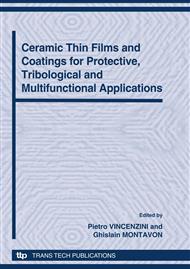p.35
p.41
p.47
p.66
p.74
p.80
p.86
p.92
p.100
Oxidation Behavior of Thermal Barrier Coatings on Copper Substrates
Abstract:
In rocket engine combustion chambers, the cooling channels experience extremely high temperatures and environmental attack. Thermal protection can be provided by Thermal Barrier Coatings. Due to the need of good heat conduction, the inner combustion liner is made of copper. The performance of a standard coating system for nickel based substrates is investigated on copper substrates. Thermal cycling experiments are performed on the coated samples. Due to temperature limitations of the copper substrate material, no thermally grown oxide forms at the interface of the thermal barrier coating and the bond coat. Delamination of the coatings occurs at the interface between the substrate and the bond coat due to oxide formation of the copper at uncoated edges. In real service a totally dense coating can probably not be assured which is the reason why this failure mode is of importance. Different parameters are used for thermal cycling to understand the underlying mechanisms of delamination. Furthermore, laser heating experiments account for the high thermal gradient in real service. Pilot tests which led to a delamination of the coating at the substrate interface were performed successfully.
Info:
Periodical:
Pages:
74-79
Citation:
Online since:
October 2010
Authors:
Price:
Сopyright:
© 2010 Trans Tech Publications Ltd. All Rights Reserved
Share:
Citation:


